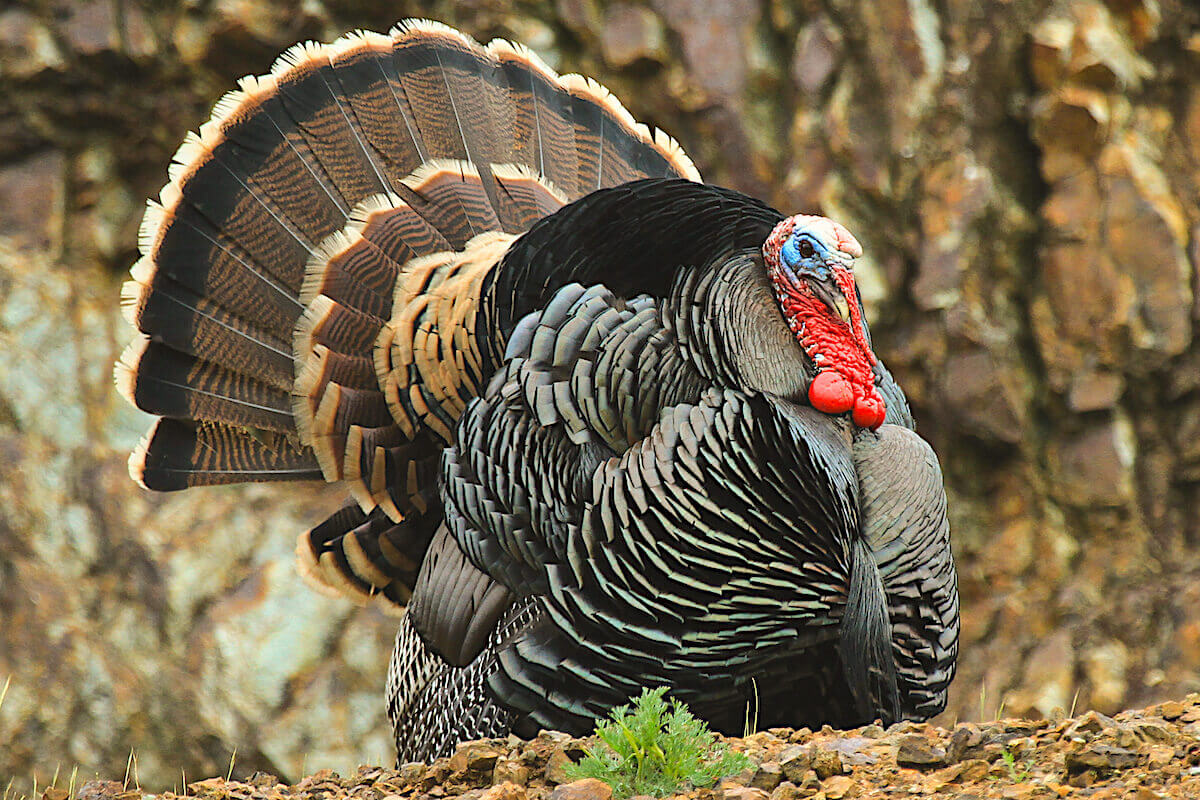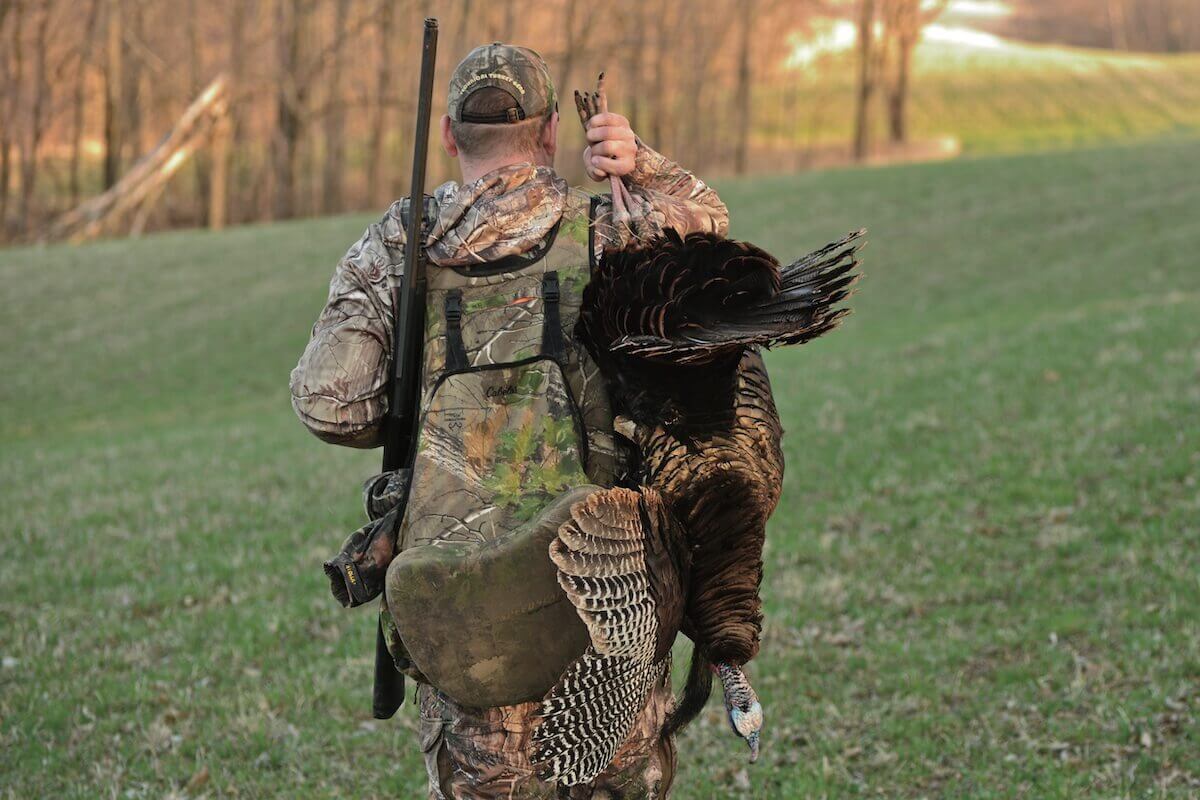
If a gobbler is traveling with a hen, hit them with some cutts. These sounds provoke aggressive responses from hens. If she comes in, the tom should follow. (Shutterstock image)
- This article on turkey hunting is featured in the Midwest edition of March’s Game & Fish Magazine. Learn how to subscribe
When I started turkey hunting as a clueless 14-year-old, the loudest voices in the expert turkey space all said the same thing:
Yelp three times and shut up. Those were the dark ages of turkey hunting.
Since then, we’ve learned just how conversational turkeys can be—and how deep their vocabulary really is. To be a consistently successful turkey hunter, you need to understand this proclivity for conversation and know how to interact with turkeys accordingly.
1. YELPS
If you can’t yelp, you can’t call turkeys. This call functions to serve several purposes. The ladies use it to keep track of one another (gobblers too, just less frequently). Hens also use it to rope in a randy gobbler, and a good series of yelps often leads to other calls as intensity ramps up.
The key to understanding yelps is grasping cadence and structure. A yelp is a two-note call that drops off sharply at the end. Most beginners default to a one-note yelp, and it doesn’t work.
They also string their yelps together too quickly, which sounds unnatural. Whether you use a diaphragm call, slate or box, think “slow and purposeful” with your two-part yelps.
2. PURRS
Most of the purring you’ll hear from wild turkeys will come from hens as they preen themselves and slowly, contentedly pick their way past your blind. When birds fight, especially gobblers, they’ll engage in a souped-up purr that often transitions into other calls, but what most hunters should think about is the softer version. This is an all-clear, confidence-boosting call.
Whether you channel your inner Cajun and roll your Rs with a mouth call or drag a striker softly across a slate, this call is for close birds that need a little coaxing to cross the red line. It’s a great way to convince a hung-up gobbler that he should cover the last 50 or so yards.
3. CLUCKS
The cluck, a one-note sound that might remind you of that of a chicken, falls close to the purr on the vocalization spectrum. Content turkeys cluck, just like they purr. The two sounds are often made back-to-back, and if you learn how to do this, you can further sell the ruse that all is good with your faux flock.
The easiest way to do this is to end a purr on a slate call with a quick, soft pop of the striker. The key here is subtlety, just like it is if you make clucks with a mouth call. Content birds don’t scream their lungs out, so you want to keep your library voice going here. Again, if you’ve got birds that are hung up or respond negatively to more aggressive calling, clucking might be the ticket.
4. CUTTS
Cutting is the “come at me, bro” of the turkey vocabulary—though, technically, it’s more of a “come at me, sis.” This sound, which really ramps birds up, can be made like a cluck on a slate call but with some serious force and rapid-fire succession. It often triggers a dominant response from hens, which usually pulls in the boyfriends and can turn a dead setup into an action-packed gobble fest.
The cutt is also easy to make with a mouth call, but probably best created with a box call. Ensure you’re chalked up and confident, and tilt the paddle at as much an angle as you can. Then, bring it home with authority several times in a row.
Cutting, like all calling, is situationally specific. If you’ve got a hen that’s chatty, you’re off to a good start. You can also use the cutt around midday when nothing is going on, but you’ll want to start with softer yelps and purrs first. I often use two separate calls—a slate and a mouth call, for instance—to create calling sessions that sound like hens getting after one another. These sessions always lead to aggressive cutting, and they’ve brought in many longbeards over the years, especially on heavily pressured public ground.
5. GOBBLES
We all know what a gobble is, but most of us don’t actually know when to use it as a call. The best answer is “not very often.” Gobbling is something to consider if you know for certain that no one can potentially sneak up and shoot you with a load of No. 4s. It’s also a last resort for a hung-up gobbler that you can see but who just doesn’t believe your normal turkey talk. Occasionally, the competition aspect of throwing a gobble into the mix does the trick and you can coax a longbeard in closer.
There are gobble-shaker calls out there, but you can also hold a box call upside down and quickly shake it back and forth for a passable gobble. If you’re confident with a mouth call, you can shake your head like a lunatic and create a loud, realistic-sounding gobble that will have spit flying and your snoozing hunting partner checking his underwear. While a gobble might not be a great call for very many situations when you want to draw a longbeard into range, it’s an excellent locator call. In fact, in my experience, it’s the best one out there.

Locator Lowdown
Play a productive game of Marco Polo with toms.
As discussed, if you can gobble, you can get turkeys to gobble, which is the whole point of a locator call. Also, as mentioned, it’s not always smart to go around sounding exactly like the thing everyone in the woods is trying to kill. Fortunately, you’ve got other options.
Crow calls, owl hooters and even peacock calls are all available to spring longbeard chasers who just need to hear a few real birds to devise a plan. If you’re trying to roost a bird, an owl hooter is tough to beat (although a gobble is as good or better). If you’re running and gunning all day long and just want a midday bird to sound off, try a simple crow call. The best for this is a series of five caws, with the first three drawn out and the last two made very quickly (listen to real crows and this will make sense).

CLUTCH CALLS
Seven of the best turkey calls to carry this spring
Owning—and knowing how to use—a variety of calls improves your odds in the spring. While plenty of options exist, running diaphragm calls like the Primos Veronica ($6.99; primos.com) is an excellent way to expand your vocabulary. This three-reed, spur-cut mouth call is designed so that users can produce everything from the high-pitched kee-kee to a low-and-slow raspy yelp. Another great option for mouth calls is the Hunter Specialties Tongue Series ($29.99; gsmoutdoors.com). A four-pack contains options for producing every sound a turkey can make thanks to the unique cuts of the latex.
Naturally, you’ll want more than diaphragm calls, and no turkey hunter worth his or her salt would be caught dead in the woods without a box call and a pot call. In the former category, it’s hard to find a better option than Zink’s Wicked Series Box ($119.99; zinkcalls.com). This premium call is hand-built, hand-tuned and is double-sided to allow for different tones. Pot call fanatics should check out Flextone’s Pot Luck Glass ($12.99; flextonegamecalls.com). This compact and weatherproof call is designed to keep working even when the rain comes, all while producing crisp, loud-as-you-need-them sounds.










































